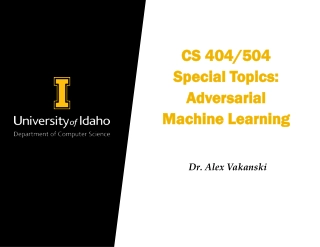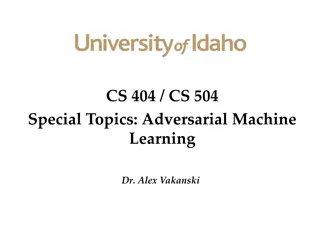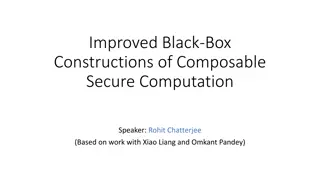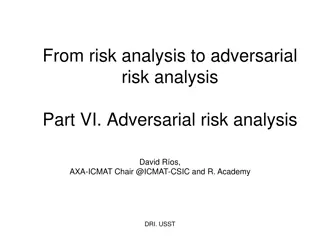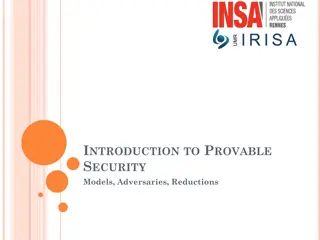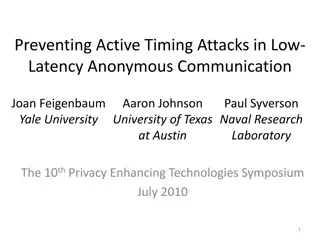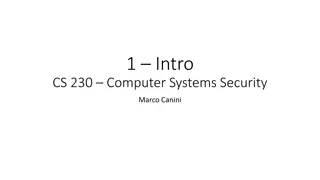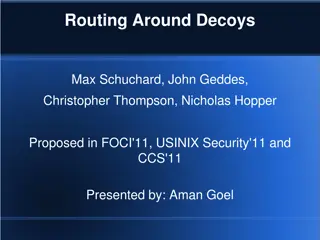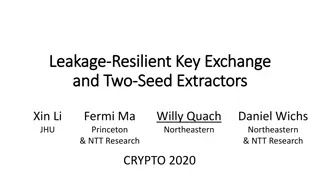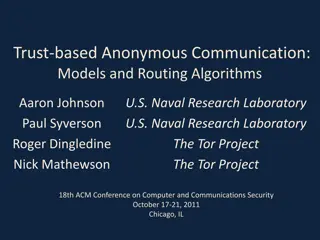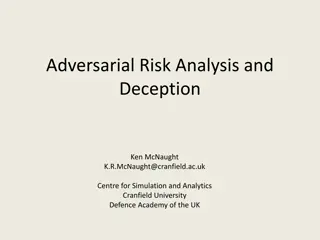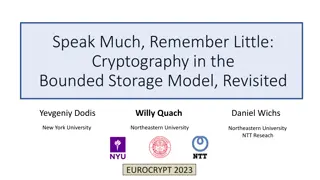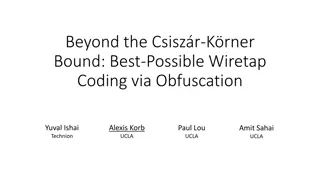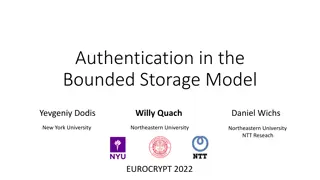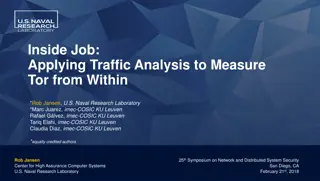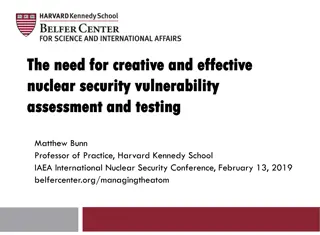Adversarial Machine Learning in Cybersecurity: Challenges and Defenses
Adversarial Machine Learning (AML) plays a crucial role in cybersecurity as security analysts combat continually evolving attack strategies by malicious adversaries. ML models are increasingly utilized to address the complexity of cyber threats, yet they are susceptible to adversarial attacks. Inves
4 views • 46 slides
The Legendary Strength of Hercules: Mythical Hero and Divine Tasks
Hercules, the mythical Roman hero and son of Zeus, is renowned for his incredible strength and the twelve labors imposed on him by Hera. Despite facing challenging tasks, Hercules triumphed with his unmatched courage and power, securing his place as a legendary figure in mythology. Discover the epic
2 views • 16 slides
Adversarial Machine Learning in Cybersecurity
Adversarial Machine Learning (AML) is a critical aspect of cybersecurity, addressing the complexity of evolving cyber threats. Security analysts and adversaries engage in a perpetual battle, with adversaries constantly innovating to evade defenses. Machine Learning models offer promise in combating
1 views • 43 slides
Enhanced Security in Multiparty Computation
Explore the improved black-box constructions of composable secure computation, focusing on definitions, objectives, and the formalization basics of multiparty computation (MPC). Learn about the motivating security aspects in MPC and the real/ideal paradigm. Discover how MPC security involves compari
1 views • 68 slides
Sally Lockhart Investigates Mysteries in Victorian London
Sally Lockhart, upon her father's mysterious death, delves into dangerous mysteries while avoiding the ominous "Seven Blessings." With the help of new friends, Sally uncovers secrets surrounding a valuable Ruby and her father's demise, eventually confronting dangerous adversaries and discovering hid
0 views • 9 slides
Sharding and Scaling in Blockchain: Overcoming Limitations for Improved Performance
Sharding and scaling play a crucial role in enhancing the performance of blockchain networks. This lecture explores how sharding helps distribute the workload efficiently, enabling better storage, computing, and communication scalability. The concept of randomized node allocations and adaptive adver
0 views • 10 slides
Analyzing Security Resource Allocation in Railway Networks
Analyzing the best security resource allocation strategy in a railway network involving stations, lines, and potential threats like pickpocketing, fare evasion, and terrorism. Discusses the importance of predictive models, constraints, and optimal resource allocation to combat organized adversaries.
2 views • 38 slides
Anansi the Spider: A Tale of Trickery and Resilience
Anansi the Spider, originating from Ghana, is a prominent figure in West African folklore known for his cunning and ability to outsmart more powerful adversaries. This tale explores Anansi's role as a trickster and his significance in the African diaspora, particularly in Jamaica. Through oral and w
2 views • 10 slides
Provable Security Models in Cryptography
Cryptography and cryptology involve secure communication techniques to protect data from third-party adversaries. This article introduces provable security models, cryptographic goals like confidentiality and authenticity, and the approach of security by trial-and-error versus provable security meth
2 views • 48 slides
Intercept X - Early Access Program Overview
Intercept X's Early Access Program offers advanced security solutions to combat active adversaries and advanced malware. The program covers deep learning techniques, false positive mitigations, and credential theft protection. It focuses on protecting against various threats such as credential theft
0 views • 14 slides
Hardness of Proving CCA-Security in Signed ElGamal
Bogdan Warinschi from the University of Bristol, along with David Bernhard and Marc Fischlin, discusses the challenges in proving the chosen-ciphertext security of signed ElGamal encryption schemes. The potential solution involves adding a proof of knowledge to ciphertexts to prevent adversaries fro
0 views • 26 slides
IEEE 802.11-17/1373r1 PHY Security Overview
This document outlines the security requirements for the IEEE 802.11-17/1373r1 protocol, focusing on authentication, encryption algorithms, key management, and message integrity in both associated and unassociated states. It also addresses securing against adversaries with specified response times,
1 views • 10 slides
Preventing Active Timing Attacks in Low-Latency Anonymous Communication
This research addresses the vulnerabilities of onion routing to timing attacks and proposes solutions to prevent active timing attacks, focusing on low-latency anonymous communication systems. Various problems related to timing attacks in onion routing are analyzed, including the role of adversaries
1 views • 52 slides
Enhancing Operational Security: Protecting Critical Information
Introduction to Operational Security (OPSEC) and its importance in safeguarding critical information from adversaries. The process involves identifying, analyzing threats and vulnerabilities, conducting risk assessments, and applying appropriate OPSEC measures. Loose Lips Sink Ships emphasizes regul
1 views • 15 slides
Insights on Environmental Security and Ingenuity
In this tribute to Ran Canetti, insights are shared on environmental security, ingenuity, and secure multi-party computation (MPC). The discussion delves into the essence of ingenuity, addressing why some may misunderstand discoveries. Furthermore, the concept of environmental security and its pivot
0 views • 11 slides
Challenges in Computer Systems Security
Understanding security in computer systems involves achieving goals in the presence of adversaries. However, this task is challenging due to the need to guarantee policies in the face of realistic and open-ended threat models. Issues can arise from problems with policy formulation, assumptions in th
1 views • 16 slides
Reliable Communication in the Presence of Limited Adversaries Study
This study by Sidharth Jaggi from The Chinese University of Hong Kong delves into reliable communication in scenarios with limited adversaries. The research group focuses on designing and optimizing codes, algorithms, and networks for information theory, exploring various background communication sc
0 views • 33 slides
Carnegie Mellon Secure Systems Verification Research
Carnegie Mellon University's research focuses on secure hypervisor systems, address space separation, and verification tasks to ensure security properties in the presence of adversaries. Challenges include scalability in model checking due to complex data structures in address translation. The aim i
4 views • 20 slides
Introduction to Cryptography and Its Applications in Computer Science
Cryptography is the study of methods for sending and receiving secret messages. In this lecture, we explore the design and application of cryptosystems, such as the RSA cryptosystem and Turing's Code. The goal is to securely encrypt and decrypt messages using number theory to protect communication f
2 views • 53 slides
Decoy Routing: A Tool Against Internet Censorship
Modern censorship resistance tools like decoy routing provide a new approach against web censorship at a nation-state level. Decoy routing involves placing a proxy in the middle of paths to hide user packets from detection by adversaries. The use of decoys helps in avoiding the enumeration of censor
1 views • 20 slides
Round-Efficient Byzantine Broadcast Under Strongly Adaptive and Majority Corruptions
This paper discusses a round-efficient Byzantine broadcast protocol that addresses strong adaptive adversaries and majority corruptions. The protocol involves unique and unbreakable peer signatures, committees for message verification, and time-locking mechanisms to prevent message tampering. By uti
3 views • 5 slides
Limitations of Deep Learning in Adversarial Settings
Deep learning, particularly deep neural networks (DNNs), has revolutionized machine learning with its high accuracy rates. However, in adversarial settings, adversaries can manipulate DNNs by crafting adversarial samples to force misclassification. Such attacks pose risks in various applications, in
0 views • 38 slides
Adversarial Risk Analysis for Urban Security
Adversarial Risk Analysis for Urban Security is a framework aimed at managing risks from the actions of intelligent adversaries in urban security scenarios. The framework employs a Defend-Attack-Defend model where two intelligent players, a Defender and an Attacker, engage in sequential moves, with
2 views • 26 slides
Enhancing Incident Response Through Threat Intelligence
Explore the importance of threat intelligence in incident response, covering aspects such as understanding adversaries, assessing risks, evaluating threats, and leveraging strategic intelligence. Learn how organizations can benefit from a proactive approach to cybersecurity by utilizing threat intel
1 views • 18 slides
Biological Adversaries: Education Levels and Demographics
Exploring the traits of biological adversaries, this study reveals that perpetrators with higher education levels are more likely to successfully use chemical and biological agents. Success tends to increase with age and years of activity. Most individual perpetrators originate from the MENA region,
1 views • 16 slides
Defend the Defenders: Managing and Participating in Excellent Teams with Seth Hanford
Join Seth Hanford at DEFEND THE DEFENDERS conference where he shares insights on managing and participating in excellent teams. Learn about solving problems with limited resources, combating human adversaries, and attracting and retaining the right people. Whether you are an individual defender or a
0 views • 27 slides
The Dangers of Cloud Monocultures in Information Technology
Gene Spafford highlights the risks of consolidating critical information in the cloud, noting that the concentration of key resources creates a target for adversaries. Monocultures, where systems run identical software components, increase vulnerability to malware attacks. The example of OpenSSL's b
0 views • 57 slides
Leakage-Resilient Key Exchange and Seed Extractors in Cryptography
This content discusses the concepts of leakage-resilient key exchange and seed extractors in cryptography, focusing on scenarios involving Alice, Bob, and Eve. It covers non-interactive key exchanges, passive adversaries, perfect randomness challenges, and leakage-resilient settings in symmetric-key
6 views • 35 slides
Trust-Based Anonymous Communication Models and Routing Algorithms
This research paper discusses trust-based anonymous communication models and routing algorithms in the context of onion routing, emphasizing the importance of trust in mitigating security risks from adversaries with resources. The paper presents a model of trust and proposes trust-based routing algo
0 views • 65 slides
Deception in Risk Analysis and Military Scenarios
Deception plays a crucial role in risk analysis, particularly in military scenarios where adversaries employ strategies to mislead and confuse. This involves reasoning under uncertainty, employing tactics like feint attacks, counter-recce activities, dummy airfields, and more. Understanding the use
0 views • 31 slides
Cryptography in the Bounded Storage Model: Revisited - Eurocrypt 2023
Cryptography researchers revisit the Bounded Storage Model (BSM) to enhance security in transmitting messages while considering limited storage capacities. The BSM restricts adversaries to limited storage, enabling unconditional security. The model aims to address challenges in message transmission
0 views • 16 slides
Best-Possible Wiretap Coding: Beyond the Csiszr-Krner Bound
Explore the concept of wiretap coding for secure communication in scenarios with eavesdroppers. This content delves into formal definitions, impossibility scenarios, and the quest for achieving secure transmission between parties without compromising data privacy. Learn about encryption schemes, adv
0 views • 44 slides
Oblivious RAM and Software Protection: An Overview
Oblivious RAM (ORAM) and software protection against piracy involve securing hardware and encrypted programs to prevent unauthorized access. With a focus on achieving security through encryption and indistinguishability, concepts like access patterns and data request sequences play a crucial role. T
0 views • 26 slides
Cryptography in Bounded Storage Model: Ensuring Secure Communication
Cryptography in the Bounded Storage Model provides insights into securing communication with secrecy and authenticity. The model limits adversaries' memory without runtime restrictions, ensuring unconditional security for various primitives. Explore how this model safeguards messages from eavesdropp
1 views • 42 slides
Traffic Analysis for Measuring Tor from Within
Study by Rob Jansen and team explores traffic analysis techniques to measure Tor from within the network, focusing on website and onion service fingerprinting. The research examines the limitations of entry positions and advantages of middle relays in fingerprinting attacks on Tor. By considering ad
0 views • 25 slides
Power Mapping: A Visual Tool for Advocates to Influence Change
Power mapping is a visual tool used by advocates to identify key individuals to target in order to effect change. It involves mapping the community around an issue or campaign, identifying decision-makers, adversaries, and influential stakeholders. By following important steps and asking relevant qu
0 views • 10 slides
Enhancing Nuclear Security Through Creative Vulnerability Assessment
Creative and effective vulnerability assessment and testing are essential in nuclear security to identify weaknesses and improve defense systems against intelligent adversaries. The need for in-depth assessment and realistic testing is emphasized to uncover vulnerabilities that adversaries may explo
0 views • 8 slides
Security Against Malicious Adversaries: Issues and Solutions
This content discusses security measures against malicious (active) adversaries in cryptographic protocols. Topics include handling input dependencies, randomness, fairness, and deviation from protocol instructions. It explores solutions such as the GMW Compiler Theorem, input independence, coin-tos
1 views • 27 slides
Modern Cryptography: Key Concepts and Practical Aspects
Explore the key concepts of modern cryptography including adversaries, cryptographic algorithms, computational strength of adversaries, and practical attacks. Learn about the requirements and principles of cryptographic algorithms for secure communication. Discover how cryptography protects informat
0 views • 51 slides
Efficient Multiparty Computation for Matrix Rings against Malicious Adversaries
Explore the development of efficient multiparty computation protocols for non-commutative rings, specifically focusing on matrix rings, in the dishonest majority setting to combat malicious adversaries. This study, presented at ASIACRYPT 2024, delves into the significance of utilizing matrix rings i
0 views • 19 slides
